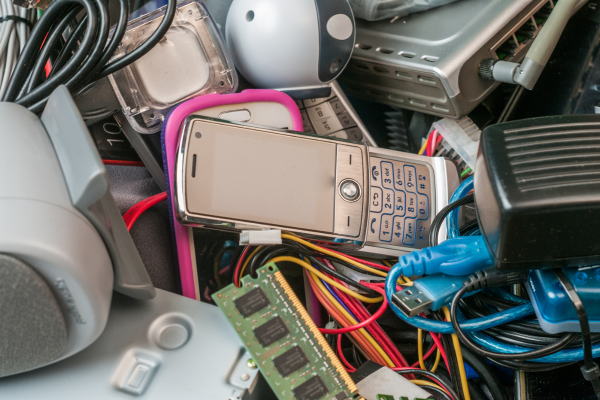Guest blog by Landbell Canada
The global e-waste crisis is escalating at an alarming rate. A record 62 million tonnes (Mt) of e-waste was produced in 2022, up 82% from 2010, according to the Global E-Waste Monitor 2024. This surge is largely attributed to the increasing demand for electronic devices and the short lifespan of many products. If left unchecked, the growing volume of e-waste could have severe environmental and health consequences. As we celebrate #CircularEconomyMonth, it is imperative to understand the importance of e-waste recycling and take action to reduce its impact on our planet.
What is E-Waste?
E-waste refers to any electronic or electrical equipment that has reached the end of its useful life. This includes items such as computers, printers, monitors, televisions, smartphones, tablets, appliances, and batteries. E-waste often contains valuable materials like metals, plastics, and glass, but it also contains hazardous substances such as lead, mercury, cadmium, and chromium. If not recycled properly, these hazardous substances can leach into the environment, contaminating soil, water, and air.
Why is E-Waste Recycling Important?
E-waste recycling is crucial for several reasons:
- Resource Conservation: Recycling e-waste helps conserve valuable resources by recovering valuable materials that can be used to manufacture new products. This reduces the need for mining and extraction of raw materials, which can have a significant negative impact on the environment.
- Environmental Protection: E-waste contains hazardous substances that can pose serious health risks if not disposed of properly. By recycling e-waste, we can prevent these substances from entering the environment and contaminating our ecosystems.
- Economic Benefits: E-waste recycling can create jobs and stimulate economic growth. The recycling industry provides employment opportunities for people involved in collection, sorting, and processing e-waste.
- Social Responsibility: E-waste recycling is a socially responsible practice that helps to protect our planet and future generations. By choosing to recycle our electronic devices, we are demonstrating our commitment to sustainability and environmental stewardship.
What to Recycle?
Almost all electronic devices can be recycled. Here are some examples of common e-waste items that can be recycled:
- Computers: Desktops, laptops, tablets, and netbooks
- Monitors: CRT and LCD monitors
- Printers: Laser and inkjet printers
- Scanners: Flatbed and document scanners
- Televisions: CRT, LCD, and plasma televisions
- Smartphones and tablets: Mobile phones, tablets, and e-readers
- Appliances: Refrigerators, ovens, washing machines, dryers, and microwaves
- Batteries: Rechargeable and non-rechargeable batteries
Where to Recycle E-Waste?
There are many options for recycling e-waste. Here are some common places where you can drop off your electronic devices:
- Electronics Retailers: Many electronics retailers offer e-waste recycling programs. You can often drop off your old devices at their stores for free.
- Municipal Recycling Centers: Many cities and towns have designated recycling centers where you can dispose of e-waste.
- E-Waste Collection Events: Some communities organize e-waste collection events where you can bring your electronic devices for recycling.
- Electronics Recyclers: There are many private companies that specialize in e-waste recycling. You can find their contact information online or in your local phone directory.
What Happens if We Don’t Recycle E-Waste?
If e-waste is not recycled properly, it can have serious consequences for both human health and the environment. Here are some of the potential risks:
- Hazardous Substances: E-waste contains hazardous substances such as lead, mercury, cadmium, and chromium. These substances can leach into the environment and contaminate soil, water, and air.
- Health Risks: Exposure to these hazardous substances can cause a variety of health problems, including respiratory issues, neurological disorders, and cancer.
- Environmental Damage: E-waste can also harm wildlife and ecosystems. For example, lead from discarded batteries can accumulate in the soil and water, posing a risk to animals and plants.
- Resource Depletion: If e-waste is not recycled, valuable materials are lost, which can lead to increased mining and extraction of raw materials.
Encouraging E-Waste Recycling: A Call to Action
To address the growing e-waste problem, it is essential to encourage individuals and businesses to adopt sustainable practices. Here are some steps that can be taken to promote e-waste recycling:
- Raise Awareness: Education and awareness campaigns can help people understand the importance of e-waste recycling and the negative consequences of improper disposal.
- Improve Accessibility: Ensuring that e-waste recycling facilities are easily accessible to everyone is crucial. This includes providing convenient drop-off locations and transportation options.
- Support Recycling Programs: Governments, businesses, and individuals should support e-waste recycling programs and initiatives. This can involve providing funding, promoting recycling, and implementing regulations to ensure responsible e-waste management.
- Extend Product Lifespan: Encouraging manufacturers to design products that are more durable and repairable can help reduce the overall volume of e-waste.
- Develop Circular Economy Models: Transitioning to a circular economy where products are designed for reuse, repair, and recycling can help minimize the environmental impact of e-waste.
The growing e-waste crisis demands immediate action. By understanding the importance of e-waste recycling, taking steps to reduce our consumption of electronic devices, and supporting responsible recycling practices, we can contribute to a more sustainable future. Landbell Canada is committed to helping businesses navigate the complex landscape of e-waste regulations and compliance. Our expertise in e-waste management can assist organizations in developing effective recycling programs, ensuring proper disposal of electronic devices, and mitigating environmental risks. Together, we can work towards a circular economy where e-waste is minimized and valuable resources are conserved.
If you’d like to read through a variety of e-waste and recycling-related articles, visit the Landbell Canada blog. We’re constantly updating our website to keep you, the environmentally conscious consumer or business, informed. Let’s embrace the challenge and take action to protect our planet.
